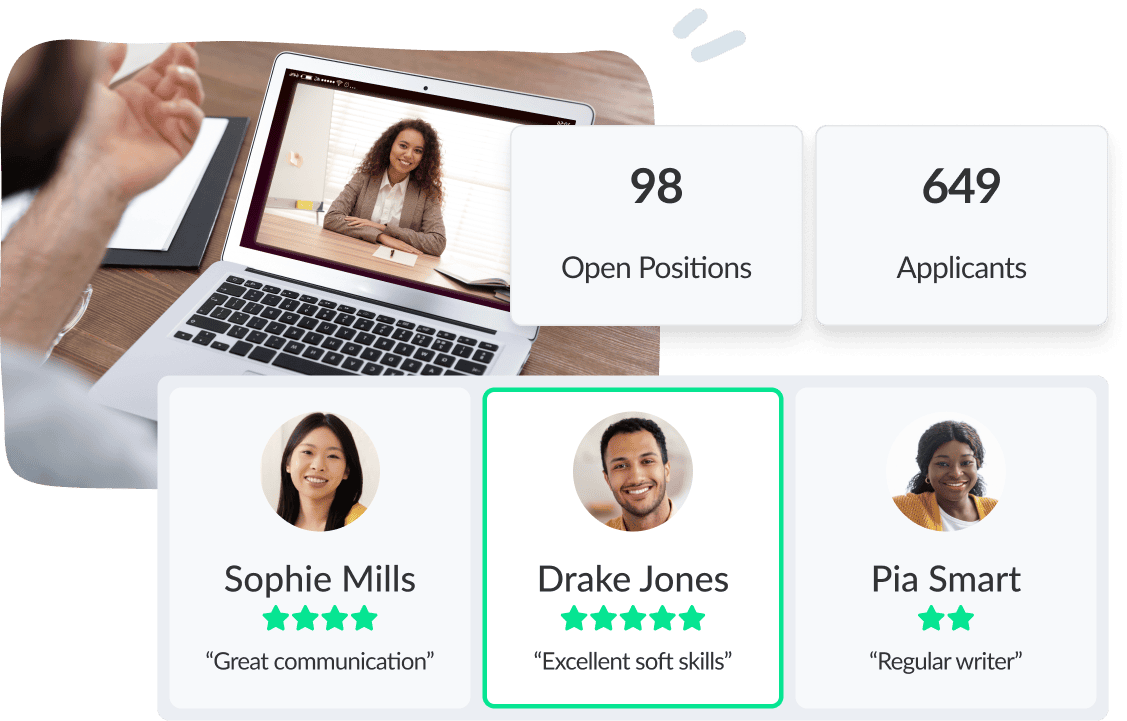
What Is Recruitment Automation?
Improve your hiring with automation. Streamline candidate screening, engagement, and analytics.

TL;DR: ATS Pros and Cons
A growing number of companies are using an applicant tracking system (ATS) every day. The most important goal of using an ATS is to increase the quality of hires, while also reducing both time-to-hire and cost-of-hire.
Let’s explore the benefits and compare some ATS pros and cons.

These systems are becoming increasingly popular among companies of all sizes to manage the recruiting process. Below are the top reasons why employers choose to use an ATS.
A consistent, organized process
Create a single, repeatable process with all applicant information stored centrally.
Important hiring process insights
Measure hiring performance to identify and remove bottlenecks in your process.
Manage large applicant volumes
Track and communicate with hundreds or thousands of candidates at once.
The most important benefit of using an ATS is to increase the quality of hires. By using an ATS you can do this while also reducing both time-to-hire and costs-of-hire.
Below are key benefits that lead to those outcomes.
One of the key employer benefits is a more structured and streamlined process. Workflow automation and centralized data helps teams stay organized. Automation can keep the process moving forward from job requisitions to onboarding while reducing the recruiters’ workload. An ATS ultimately reduces the cost of hiring by being more efficient with time and resources.

An ATS streamlines the hiring process by consolidating all information and communication in one platform, reducing the time and effort required for manual tracking and individual candidate coordination.
Through automation, most applicant tracking systems:
Organizations that use an applicant tracking system save time screening candidates and also improve their ability to identify top talent. Hiring managers can identify specific skills and qualifications and request recruiters to tag in the profiles.
Some positions may require specific skills, certifications or qualifications. The use of knockout questions in the application form benefits employers by ensuring they only interview applicants who meet the criteria to advance to the next stage.
Don’t risk losing top talent once you’ve identified them. Qualified candidates are on the market for as little as 10 days. This is why using an ATS is important—to keep top talent advancing through your process.
Do you have trouble finding qualified candidates? Are you hiring for hard-to-fill positions? ATS provides many advantages during candidate sourcing:

Every inter-departmental team benefits from improved collaboration. Automating the job requisition process keeps things moving by allowing managers to complete a preset form with an automated approval workflow.
Sharable applicant profiles allow managers and other stakeholders to leave notes on the profiles for others to see. Collaboration keeps flowing without the need to schedule meetings.
Automated notifications can keep processes from getting stuck. Hiring managers are alerted when a candidate’s status has changed or a quick reminder to complete an evaluation.
In a competitive market, it’s important to stand out in a good way to reduce drop-offs, creating an engaging candidate experience benefits both employers and applicants. In an increasingly competitive market, it’s important to stand out in a good way to reduce drop-offs.
Allow applicants to apply faster and hear back sooner
Let candidates choose when and how they interview
Nurture candidate relationships with timely messaging
Incorporate feedback from applicant surveys
Save applicant profiles for future role consideration
Make onboarding easy by staying in touch
Automating communications can help organizations maintain consistent and quality contact with large volumes of candidates. Keeping candidates informed and up-to-date about their process creates a positive perception of the organization to rise above a troubling trend.
Applicant tracking platforms are important tools for storing all candidate information in a secure location. Centralized access benefits all team members in that everyone can see where each candidate is.
The system updates an applicant’s profile as they progress through the hiring process. It can add evaluations or interview scores as a stage completes to maintain profile integrity.
A well-integrated system operates as a single source of truth, benefiting the organization by reducing inconsistencies and data loss in manual information transfers.

An ATS allows for easy data collection in the hiring process, helping to identify and remove bottlenecks. Multiple tools, manual processes and spreadsheets make it challenging for management to measure how much time is spent in each phase.
Accurate data facilitates process optimization, insights into hiring costs, and return on investment.
The best tracking software can help you understand:
Staying on top of regulatory requirements is an important aspect of any hiring program. Using a tracking system can benefit an organization by configuring processes and workflows to meet requirements set by EEOC, OFCCP, and GDPR.
Stay ahead of the evolving compliance landscape. The Department of Labor’s compliance assistance toolkits can help your team navigate.
There are many advantages these platforms deliver. Be mindful of potential risks as you choose and use the system. Here’s a summary of ATS pros and cons.
Reduce both time-to-hire and costs
Increase collaboration for better decision-making
Accurately measure hiring performance
By automating administrative tasks, consolidating candidate data and digitizing previously manual processes, hiring teams can use their time more effectively.
Digital records make it easy to collaborate, allowing hiring teams to include more diverse perspectives in the evaluation process.
Accurate reporting can provide valuable insights such as hiring team performance, process stage times, even rater tendencies.
You could accidentally filter out qualified candidates
Not all platforms are flexible enough to last
Applicants may try to manipulate the system
Narrow search criteria, limited keywords, or uncommon resume wording, can unintentionally filter qualified candidates.
A rigid and cumbersome platform may not be able to adapt to evolving processes and organizational goals.
Candidates may manipulate their resumes for ATS, this can include keyword stuffing, white fonting, or lying about skills. A rarely successful and unwanted outcome.
It’s important to weigh the advantages against potential drawbacks and consider what internal measures could help mitigate these risks.
Learn more about VidCruiter’s applicant tracking software
Yes, ATS solutions are available for both large enterprises and small businesses. They have different pricing models and features tailored to company size and recruitment needs. Small businesses may opt for simpler or less expensive ATS platforms, while larger organizations might require more robust, enterprise-level systems.
Hidden costs can include implementation fees, training expenses, integration costs with existing systems, and ongoing maintenance or subscription fees. It’s critical to evaluate the full cost of an ATS before purchasing to ensure it aligns with your budget and needs.
Ensure your ATS is set up to eliminate unnecessary hiring biases in candidate selection. Use inclusive language in job descriptions, implement diverse sourcing strategies, and review filtering criteria to ensure the system doesn’t unintentionally exclude candidates based on biased assumptions, subjective standards, or protected characteristics.
Modernize your hiring process with expert insights and advice.